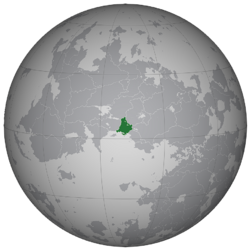Hondonia
This article is incomplete because it is pending further input from participants, or it is a work-in-progress by one author. Please comment on this article's talk page to share your input, comments and questions. Note: To contribute to this article, you may need to seek help from the author(s) of this page. |
The Republic of Hondonia | |
|---|---|
 | |
| Capital | Demirest (Demirești) |
| Official languages | Rouman Tuyan |
| Recognised regional languages | Bogmian Kodin Tayamo |
| Demonym(s) | Hondonian |
| Government | Unitary Semi-Presidential Republic |
• President | Miși Ciobanescu |
• Prime Minister | Codrin Suta |
| Legislature | Vorbirea |
| Area | |
• Total | 368,767 km2 (142,382 sq mi) |
| Population | |
• 2018 census | 17,338,142 |
• Density | 47/km2 (121.7/sq mi) |
| GDP (PPP) | estimate |
• Total | 491.5 b $ACU 393,2 b ᕋ 252.04 t ₲ |
• Per capita | 28,349 $ACU 22,679 ᕋ 14,536,418 ₲ |
| HDI (2018) | high |
| Currency | Sekinar ᕋ, Guara ₲ SEK, HDG |
| Time zone | -5 |
| Date format | dd-mm-yyyy |
| Driving side | right |
| Calling code | +37 |
| Internet TLD | .hn |
Hondonia ([hʌnˈdɔniə] ; Rouman: Ondonia ([ɔnˈdoni(j)a]
; Tuyan: - [-]
), officially The Republic of Hondonia, is a country located in central southern Thuadia. It is bordered by the Laurentine gulf to the south, Monterre to the southeast, Mustelaria to the east, [PLACEHOLDER] to the northeast via the [PLACEHOLDER] mountain range, Tiskaiya to the norht, and [PLACEHOLDER] to the west. Hondonia is comprised of 13 Provinces, the Insula Giulce Territory, and the Demirest Capital District, the country's largest city. It covers an area of 368,767 square kilometers (142,382 sq mi), with a population of 17 million. Hondonia's rich cultural heritage reflects influences by various Indigenous civilizations, Moldanian settlement, slavic migration, and immigration from various areas around the world. Rouman is one of the official languages of the ocuntry, alongside standard Tuyan, besides these there are 14 recognized regional langauges, with 10 being regional variants on the Tuyan language.
Hondonia has been inhabited by various indigenous peoples since at least 30,000 BCE, including the Tayamo, Cascati, and the Tuy-Suy. The Moldanian landed first in Insula Păsărilor in [PLACEHOLDER], and a month later on the coast of what became Noua Rumânie. By the mid-[PLACEHOLDER]th century they colonized parts of the region, establishing the Kingdom of New Roumania (Țara noii Rumâniei), with [PLACEHOLDER], now known as Demirest, as its capital. Independence from the Moldanians was achieved in [PLACEHOLDER], with what is now Hondonia emerging as the Free Kingdom of New Roumania (Țara liberă a noii României). In the 19th century the country has seen numerous amred conflicts within due to separatists and political ideologies, leading to the Hondonian civil wars. In [PLACEHOLDER] the current Republic of Hondonia was founded, and has seen an increase in stability, enough so that it was able to join the Sekidean Union in the year of [PLACEHOLDER].
Hondonia is a very culturally and biologically diverse nation. It's territory comprized rainforests, highlands, grasslands and alpine regions. Hondonia's national animals are the coatimundi and the verious macaw species, other national symbols include [PLACEHOLDER].
Hondonia is a member of major global and regional organizations like the Sekidean Union and [PLACEHOLDER]...
Etymology
History
Prehistory
Indigenous people inhabited the territory that is now Hondonia by 30,000 BCE, various hunter-gatherer societies existed near the present-day province of Noua Rumânie de Nord, they traded with one another and with cultures living in the Demir River valley. The oldest archaeological finds are from the Calul Mare archaeological site and Cioară Albă archaeological site in the Demir Valley 100 kilometres (62 mi) northeast of Demirest in the Noua Rumânie de sud province, these sites date from ~30,000-10,000 BCE. At Piatra Mare archaeological site and other sites, traces from the Archaic period in Hondonia (~10,000–2,000 BCE) have been found. Vestiges indicate that there was also early occupation in the provinces of Stânca Albă, Tibitau and Ciuperci de Piatră in Loc Mare. The oldest pottery discovered in Hondonia, found at Inaești archaeological site, dates to ~9,000–7,000 BCE.
Geography
Climate
Biodiversity
Government and politics
Foreign affairs
Military
Administrative divisions
| Provinces of Hondonia | |||||||||||||||||||||||||||||||||||||||||||||||||||||||||||||||||||||||||||||||||||||||||
|---|---|---|---|---|---|---|---|---|---|---|---|---|---|---|---|---|---|---|---|---|---|---|---|---|---|---|---|---|---|---|---|---|---|---|---|---|---|---|---|---|---|---|---|---|---|---|---|---|---|---|---|---|---|---|---|---|---|---|---|---|---|---|---|---|---|---|---|---|---|---|---|---|---|---|---|---|---|---|---|---|---|---|---|---|---|---|---|---|---|

Cost dei Pluei [Placeholder] (Mẹtseyenọsehéné) Sant-Demir- Sier-Mar Frontarici Ensul de Jultxe Micailici [Placeholder] [Placeholder] Noù Roumanie de Nord Noù Roumanie de Sied [Placeholder] (Pomẹtsevọsehéné) Tuçong [Placeholder] Taiamenie | |||||||||||||||||||||||||||||||||||||||||||||||||||||||||||||||||||||||||||||||||||||||||
| |||||||||||||||||||||||||||||||||||||||||||||||||||||||||||||||||||||||||||||||||||||||||
Largest settlements
Economy
Demographics
Ethnic groups
Languages
Religion
Culture
Literature
Visual arts
Music
Popular culture
Cuisine
Sports
Healthcare
Education
See also

